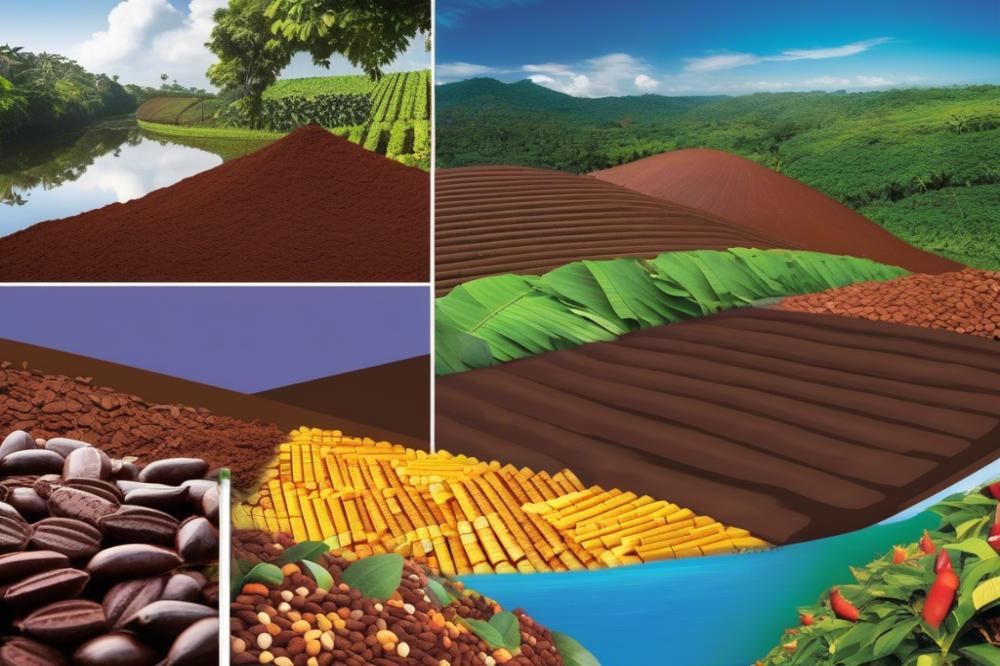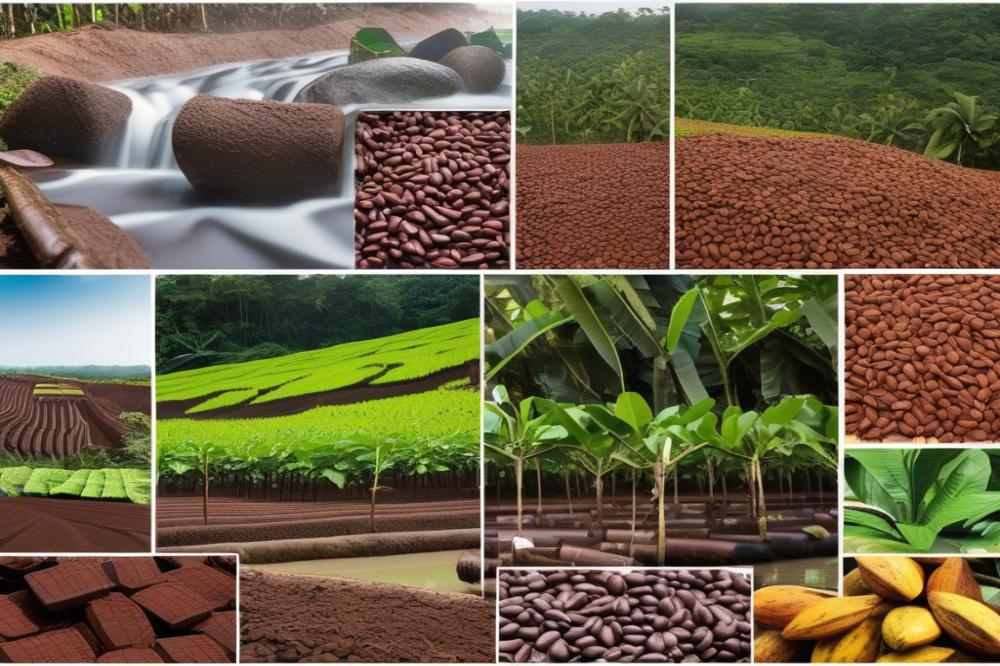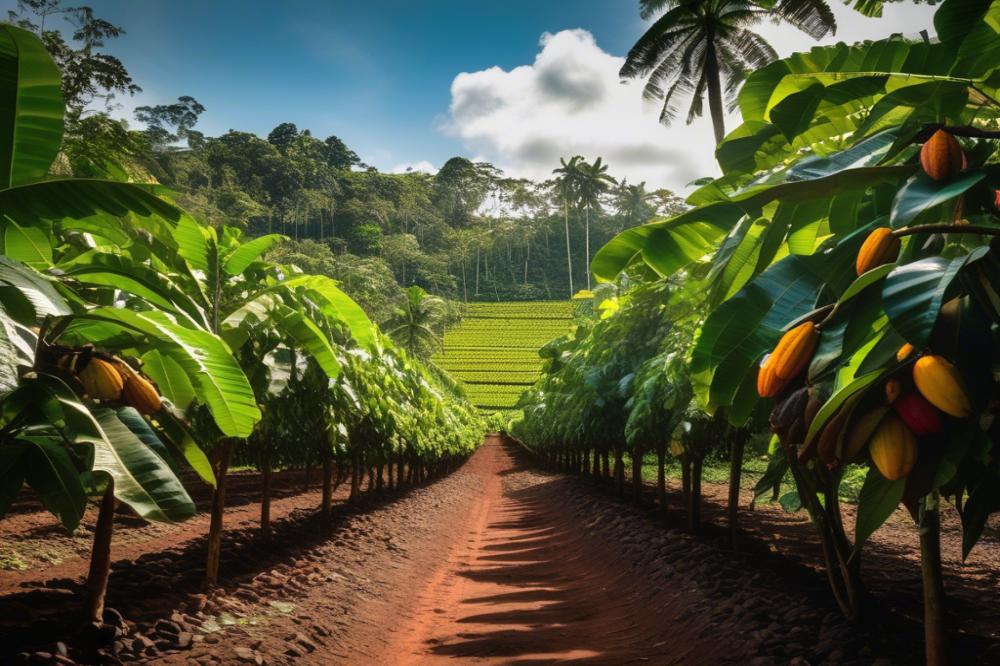Introduction
The chocolate industry is a beloved sector that captures hearts around the globe. Millions enjoy the sweet taste of chocolate every day. However, this enjoyment comes at an environmental cost. The production of cocoa has significant impacts. From deforestation to the depletion of soil health, the consequences are serious. Climate change also plays a role, affecting farming conditions in many cocoa-growing regions.
Sustainable farming of cocoa is crucial for tackling these pressing issues. By adopting practices that prioritize environmental health, farmers can help combat the negative effects. Emphasizing organic farming and agroecology allows farms to thrive without damaging the ecosystem. With a focus on biodiversity, these methods contribute positively to both the land and communities involved.
Cocoa Sustainability Practices are increasingly relevant as trends and innovations develop in the chocolate industry. Fair trade initiatives support farmers, ensuring they receive fair compensation for their labor and products. Farmer training is key, providing essential knowledge about sustainable agriculture techniques. Additionally, agroforestry methods can enhance resilience against climate fluctuations.
There is a growing demand for sustainably sourced cocoa. Consumers are becoming more aware of how their choices affect the planet. The cocoa supply chain must adapt to meet these expectations. This change not only benefits the environment but also promotes social equity in farming communities. Ultimately, embracing sustainable practices in cocoa farming can help protect our environment for the future.
Defining Sustainable Cocoa Farming

Sustainable Cocoa Farming refers to the methods and practices that allow for cocoa production while being mindful of environmental and social impacts. Principles of this approach focus on maintaining ecological balance and promoting fairness in the cocoa supply chain. Practices like agroforestry, where cocoa is grown alongside trees and other crops, enhance biodiversity and improve overall soil health. It’s not just about growing cocoa; it’s about fostering a thriving ecosystem.
Connecting sustainable cocoa farming with sustainable agriculture is essential. Both share a commitment to practices that support long-term productivity without depleting resources. Sustainable agriculture looks at broader farming systems, while sustainable cocoa farming hones in on the unique challenges within cocoa production. The two concepts aim to address the urgent issues arising from climate change and the need for resilience in farming communities.
organic farming plays a vital role in producing cocoa sustainably. By eliminating synthetic chemicals, organic practices protect local wildlife and ecosystems. Farmers often receive training on these organic methods, empowering them to cultivate cocoa in ways that are healthier for their land and communities. Engaging in fair trade allows farmers to earn better prices, supporting not only their families but also fostering local economies.
Adopting agroecology principles can enhance the sustainability of cocoa farming. This approach emphasizes working with nature to manage pests and nourish soil. Diverse planting strategies can lead to increased biodiversity, creating a more robust environment. As the world grows more conscious of the products it consumes, organic and sustainable methods stand out as crucial for the future of cocoa.
Key Practices in Sustainable Cocoa Farming

Agroforestry plays a crucial role in sustainable cocoa farming. By integrating cocoa with native tree species, farmers create a more resilient ecosystem. These trees provide shade, reduce soil erosion, and improve biodiversity. An added benefit is that shade-grown cocoa often has a higher quality and richer flavor.
Soil health management is equally essential for successful cocoa production. Implementing practices that improve soil fertility and structure can lead to healthier plants. Composting organic materials will not only enrich the soil but also encourage beneficial microorganisms to thrive. Regular crop rotation can help maintain balance and prevent nutrient depletion.
Promoting diverse ecosystems is important for biodiversity conservation within cocoa farms. Mixed cropping systems can support various species, which in turn fosters a healthier environment. A wide array of plants attracts different insects and animals, helping with natural pest control. This diversity can mitigate risks related to climate change, ensuring more stable yields over time.
Farmer training is vital for educating individuals on sustainable practices. Knowledge about organic farming techniques can empower local growers. Workshops focusing on agroecology can introduce farmers to sustainable agriculture methods that work with nature. Building strong communities around fair trade principles also helps strengthen the cocoa supply chain, allowing farmers to earn a fair income.
Fair Trade and Its Role in Sustainable Cocoa Farming

Understanding Fair Trade Concepts in Cocoa Production
Fair trade is a method designed to help cocoa farmers. It focuses on providing fair prices for their produce. Farmers face many challenges, such as climate change and unstable market prices. Fair trade aims to create stability in these situations. It promotes practices like organic farming and agroecology. These methods not only support farmers but also protect the environment.
Benefits of Fair Trade for Farmers and Communities
Many advantages come from participating in fair trade. First, farmers receive better wages. This increased income helps families thrive, reducing poverty. Communities also gain better access to resources, such as education and healthcare. Training programs in sustainable agriculture empower farmers with knowledge. They learn methods that improve soil health and biodiversity. As a result, farming becomes more productive and resilient.
Impact of Fair Trade on the Cocoa Supply Chain
Fair trade influences the entire cocoa supply chain. Buyers prefer to source from fair trade-certified farms. This choice ensures that producers meet specific standards. Higher demand for ethical products helps support sustainable practices. As a result, cocoa production can flourish without degrading the environment. More importantly, fair trade promotes transparency. Consumers become more aware of where their chocolate comes from and how it’s produced. This awareness can lead to a stronger movement toward sustainability in the industry.
Challenges Facing Sustainable Cocoa Farming
Climate change poses a significant threat to cocoa production. Rising temperatures and unpredictable rainfall patterns can harm cocoa trees. These changes impact yield and quality. Farmers face the challenge of adapting to these conditions while maintaining their crops.
Economic pressures also affect cocoa farmers deeply. Many farmers operate on tight budgets. The demand for cheaper cocoa can drive prices down. When prices fall, it becomes harder for farmers to invest in sustainable practices like organic farming or agroforestry.
Implementing sustainable practices often comes with its own set of barriers. Limited access to resources can make it tough for farmers to change methods. Education plays a crucial role. Farmer training programs can teach techniques related to agroecology and improve soil health. Yet, many small farmers lack these opportunities.
Support for sustainable cocoa initiatives is lacking as well. Investment is essential for infrastructure that can help farmers transition. Without funding, innovations in the cocoa supply chain remain untouched. Fair trade models can provide some financial relief, but more comprehensive support is needed to achieve real change. Enhancing biodiversity is another goal that requires collaboration. It helps create a more resilient ecosystem for cocoa farming, but achieving this often falls short of the necessary investment.
Innovations and Trends in Sustainable Cocoa Farming
Technological advancements have transformed sustainable practices in cocoa farming. Drones can now monitor crop health and soil quality from above. This provides farmers with real-time data, allowing them to make informed decisions about pest management and irrigation. Smart sensors help in understanding moisture levels, which is crucial for healthy crops.
Role of Certifications in Promoting Sustainability
Certifications play a vital role in the cocoa supply chain. Fair trade labels, for example, give consumers confidence that farmers receive fair wages. These certifications often encourage organic farming methods, which promote soil health and biodiversity. They also help consumers identify sustainable products, making informed choices easier.
Emerging Trends in Consumer Preferences for Sustainable Chocolate Products
Interest in sustainable chocolate products is rapidly growing among consumers. Many now seek options that highlight eco-friendly practices and ethical sourcing. This shift includes a preference for brands that support agroforestry and agroecology. Shoppers increasingly appreciate transparency in production processes, leading to increased demand for sustainably produced cocoa.
Collaborations and Partnerships in the Cocoa Industry
Creating partnerships in the cocoa industry can strengthen sustainability efforts. Non-profits, farmer associations, and chocolate companies are joining forces to enhance farmer training programs. Such collaborations aim to address challenges like climate change and deforestation. By working together, organizations can share resources and knowledge that lead to improved farming practices.
Final Thoughts
We’ve explored many aspects of sustainable cocoa farming, including its practices, challenges, and potential impact on the chocolate industry. Key points highlight that methods such as organic farming and agroforestry not only help the environment but also support farmers’ livelihoods. These strategies are vital for producing cocoa that aligns with both ecological and social values.
As we look toward the future, it’s clear that sustainable practices must play a crucial role in how chocolate is produced. The demand for ethically sourced products continues to rise. Consumers are now more aware of the impact of their choices. This awareness is essential in guiding the industry toward sustainable practices.
It is important for consumers to support brands that prioritize ethical sourcing. By choosing products from responsible producers, shoppers promote sustainable cocoa farming. Producers, on their part, should invest in training and resources that help implement these practices effectively. Collaboration among farmers, companies, and governments is critical to achieving these goals.
Policymakers need to create favorable conditions for sustainable practices to thrive. This includes supporting fair trade initiatives and funding education on sustainable methods. Everybody has a part to play in transforming the cocoa industry into a more resilient and sustainable one.
In summary, sustainable cocoa practices are more than just a trend; they are necessary for the chocolate industry’s future. Through informed choices and collective efforts, we can foster a healthier planet and a more just agricultural system.



